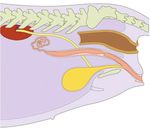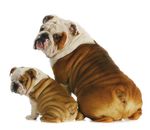Phenylpropanolamine - Duggan Veterinary
←
→
Page content transcription
If your browser does not render page correctly, please read the page content below
Urinary
incontinence
Urinary incontinence consists of the involuntary loss of urine at
inappropriate times and places. It is a chronic disease which
accompanies the animal for its entire life.
In addition to having a negative impact on the well-being of the
animal (hygienic problems; possibility of secondary
dermatological or genitalurinary infections), it is a practical
problem which increases the workload of the owner.
The condition may occur in young or adult dogs of both sexes.
However, the inability to contain the urine during filling of the
bladder happens more typically in sterilised adult bitches and
has, as a principal cause, urethral sphincter incompetence.
Symptoms
Usually animals with urethral sphincter incompetence
have a normal voluntary urination but show loss of urine
when they lie down, bark or play.
This is because of an increase in abdominal pressure
which is transmitted to the bladder by reflex. Apart from
this, the animal is HEALTHY.
The problem generally occurs at night.
Urethral sphincter incompetence
Urethral sphincter incompetence is the most common cause of incontinence in the adult bitch and usually develops months
or years after sterilisation. It is a problem with a multifactorial etiology.
ANATOMICAL CAUSE HORMONAL CAUSE
The urethra may be a little short and there may be The decrease in oestrogens associated with an
a pelvic dislocation of the neck of the bladder, increase in gonadotropins following sterilisation
following post surgical adhesion with the stump surgery are the probable causes of a decrease
of the uterus. in urethral tone.
OVARIECTOMY - OVARIOHYSTERECTOMY
Reduction in the levels of oestrogens
5,0
Estradiol (pg/ml)
4,0
3,0
2,0
pre-ovariectomy 3 6 9 12
(anestrus)
post-ovariectomy (months)
Results of a study on the effects of ovariohysterectomy on estrogen levels in the
bitch. Sterilisation causes a persistent reduction in estrogen levels compared to
those measured prior to surgery vaccination in the anestrus phase.Predisposing factors for
urinary incontinence
This is a disease which may occur in dogs of 1 - SPAYING 2 - BREED 3 - BODY WEIGHT
either sex and at any age, but various studies Ovariectomy and Large dogs:
have demonstrated the presence of Large dogs:
ovariohysterectomy • Boxer • Boxer
numerous predisposing factors which are in bitches • Doberman
associated in affected subjects. • Doberman
• German shepherd • German shepherd
• Bobtail • Bobtail
• Golden Retriever • Golden Retriever
• Irish setter • Irish setter
4 - AGE 5 - TIME OF
Dogs around Pre-puberty >
6 years old incidence (21% vs.
and over 0.5-0.6% postpuberty)
Continence is
phenylpropanolamine H2N
Phenylpropanolamine is a sympathomimetic drug, like
adrenaline and noradrenaline.
Its action takes place through stimulation of the
CH3
α-adrenergic receptors situated in the smooth muscle of
the urethral sphincter, with an increase in urethral tone and
a resulting decrease in urinary incontinence.
The effect is focused on improvement of nerve
transmission in the urethra.
Phenylpropanolamine has a less potent effect than
adrenaline and noradrenaline on the heart and on the
regulation of blood pressure, and therefore fewer side OH
effects for the animal.
What can we do to help
our pets?
Continence is a drug specifically developed for urinary
ureter incontinence in bitches.
kidney
uterur
internal The dosage starts at 1 mg/kg, 3 times per day,
sphincter of corresponding to 0.1 ml/5 kg b.w. of Continence
the urethra
hypogastric urethra 3 times per day
()
nerve
bladder
The efficacy of phenylpropanolamine in bitches is
around
90-92%
detrusor
muscle phenylpropanolamine
Phenylpropanolamine is able to act specifically on the internal sphincter
of the urethra, keeping it closed.
Its contraction permits urine to be held in the bladder.The Solution
Pharmacokinetics Treatment
Phenylpropanolamine has a mean half-life of SHORT TERM EFFICACY
around 3 hours and already reaches a plasma Control of urination already 24 hours after
peak 1 hour after oral administration. first administration.
100% efficacy after 21 days of therapy.
High tolerance LONG-TERM EFFICACY
The interval between administrations may
Repeated oral administrations for up to 3 be extended after a few weeks of
months with 5 mg/kg three times per day treatment. In most dogs, after 2 months of
(dosages 5 times higher) did not induce any treatment, 1-2 daily administrations will be
problems attributable to the treatment. sufficient.
APPLICATION OF THE SYRINGE HOLDER
1) Remove the film from the double-sided 3) Press the holder against the bottle
tape placed on the holder. for a few seconds.
2) Position the holder on one side of the 4) Replace the dosing syringe in the
bottle, close to the bottom. holder.
Easy-to-administer liquid formulation, thanks to
the special dosing syringe
Ease of administration: in the food or directly in
the mouth of the animal
Convenient for the owner
Not stressing for the animal
Already efficacious from the first administration
Long-term efficacy with no side effects or
accumulation issues
Safety closure for dogs and children
SUMMARY OF PRODUCT CHARACTERISTICS 1. NAME OF THE VETERINARY MEDICINAL PRODUCT CONTINENCE 40 mg/ml syrup for dogs. 2. QUALITATIVE AND QUANTITATIVE COMPOSITION 1 ml contains: Active substance: Phenylpropanolamine 40.28 mg equivalent to phenylpropanolamine hydrochloride 50 mg. For the full list of
excipients, see section 6.1. 3. PHARMACEUTICAL FORM Syrup. Clear colourless to pale yellow solution. 4. CLINICAL PARTICULARS 4.1 Target species Dogs. 4.2 Indications for use, specifying the target species For the management of urinary incontinence associated with urethral sphincter incompetence in the bitch, particularly
that associated with ovariohysterectomy. 4.3 Contraindications Do not administer to patients treated with non-selective monoamine oxidase inhibitors. Do not use in cases of known hypersensitivity to the active substance or to any of the excipients. Do not administer to pregnant or lactating bitches. 4.4 Special warnings for
each target species The product should be avoided in hypertensive individuals. In bitches less than 1 year old the possibility of anatomical disorders contributing to incontinence should be considered prior to treatment. The use of the product is not appropriate for the treatment of behavioural causes of inappropriate urination.
4.5 Special precautions for use Special precautions for use in animals: Phenylpropanolamine, a sympathomimetic drug, may affect the cardiovascular system, especially blood pressure and heart rate, and should be used with caution in animals with cardiovascular diseases. Care should be exercised in treating animals with
severe renal or hepatic insufficiency, diabetes mellitus, hyperadrenocorticism, glaucoma, hyperthyroidism or other metabolic disorders. Special precautions to be taken by the person administering the veterinary medicinal product to animals: Phenylpropanolamine hydrochloride is toxic when overdoses are ingested. Adverse
effects may include dizziness, headache, nausea, insomnia or restlessness, and increased blood pressure. Accidental ingestion by a child may be fatal. To avoid accidental ingestion, the product must be used and kept out of sight and reach of children. Always replace the cap securely after use and store the syringe and bottle
inside the cardboard box at all times. In case of accidental ingestion, seek medical attention immediately and show the package leaflet or the label to the physician. In the event of accidental skin contact, wash the contaminated area with soap and water. Wash hands after use of the product. In the event of accidental eye
contact, rinse the eye with clean water for about 15 minutes and seek medical advice. 4.6 Adverse reactions (frequency and seriousness) In the course of field clinical trials, loose stools, liquid diarrhoea, decrease in appetite, arrhythmia and collapse were reported in some dogs. Treatment was continued depending on the
severity of the undesirable effect observed. Sympathomimetics may produce a wide range of effects, most of which mimic the results of excessive stimulation of the sympathetic nervous system (e.g. effects on heart rate and blood pressure). Dizziness, aggressiveness and restlessness have been noted in some dogs following
treatment. Hypersensitivity may occur in very rare cases. The frequency of adverse reactions is defined using the following convention: - very common (more than 1 in 10 animals treated displaying adverse reaction(s)); - common (more than 1 but less than 10 animals in 100 animals treated); - uncommon (more than 1 but less
than 10 animals in 1,000 animals treated); - rare (more than 1 but less than 10 animals in 10,000 animals treated); - very rare (less than 1 animal in 10,000 animals treated, including isolated reports). 4.7 Use during pregnancy, lactation or lay Do not administer to pregnant or lactating bitches. 4.8 Interaction with other medicinal
products and other forms of interaction Care should be exercised in administering the product with other sympathomimetic drugs, anticholinergic drugs, tricyclic antidepressants or specific type B monoamine oxidase inhibitors. 4.9 Amounts to be administered and administration route For oral use. The recommended dose
of phenylpropanolamine is 1.5 mg/kg bodyweight (equivalent to 0.15 ml per 5 kg bodyweight) twice daily in the feed. Alternatively, 1 mg/kg bodyweight (equivalent to 0.1 ml per 5 kg bodyweight) may be administered three times daily in the feed. The absorption rate is increased if the product is administered to fasted dogs.
1. Remove the child-proof 2. Take the dosing syringe 3. Invert the bottle and, 4. Straighten the bottle and 5. Hold the dosing syringe 6. Replace the cap on the 7. Dry the tip with a clean 8. Dry carefully, making
security cap by pressing with the piston all the way holding the syringe, pull the grasp the lower part of the on top of the dog’s food and bottle and screw clockwise cloth or paper. Wash the sure that the inside of the
firmly down and rotating down and insert the tip into piston downwards aspiring syringe, close to the neck of push the piston to the to close. Keep the bottle in dosing syringe by removing syringe is dry before
anticlockwise. the dosing syringe adaptor. the product slowly into the the bottle. Remove the bottom to ensure delivery a safe place, at room the piston and rinse the reinserting the piston.
dosing syringe, to avoid the dosing syringe from the of the full dose of the temperature, out of sight items with hot water. Store the syringe inside the
formation of air bubbles. bottle by turning carefully. and reach of children. cardboard box to avoid
Stop at the mark shown on
the plunger corresponding
to the required volume of
the product.
4.10 Overdose (symptoms, emergency procedures, antidotes), if necessary Lethargy and inappetence have been reported following an overdose of 2.5 mg/kg 3 times daily. An overdose of phenylpropanolamine could produce symptoms of excessive stimulation of the sympathetic nervous system. Treatment should be
symptomatic. Alpha-adrenergic blockers may be appropriate in the case of severe overdose. 4.11 Withdrawal period(s) Not applicable. 5. PHARMACOLOGICAL PROPERTIES Pharmacotherapeutic group: Genito-urinary system and sex hormones, urologicals, phenylpropanolamine. ATC vet code: QG04BX91. 5.1 Pharmacodynamic
properties Phenylpropanolamine is a racemic mixture of D and L enantiomers. Phenylpropanolamine hydrochloride is a sympathomimetic agent which acts by direct stimulation of the smooth muscle of the internal urethral sphincter. It is an analogue of the endogenous sympathomimetic amines. Phenylpropanolamine
hydrochloride has weak sympathomimetic activity and produces a wide range of pharmacological effects. It appears to act directly on the smooth muscle of the lower urinary tract. The smooth muscle is thought to be largely responsible for the maintenance of tone in the resting state. The clinical effect of
phenylpropanolamine in urinary incontinence is based on its stimulation effect on α-adrenergic receptors. This causes an increase in, and a stabilisation of, the closure pressure in the urethra, which is innervated mainly by adrenergic nerves. 5.2 Pharmacokinetic particulars In the dog, the mean half-life of
phenylpropanolamine is approximately 3 hours with maximal plasma concentrations being found after approximately 1 hour. No accumulation of phenylpropanolamine has been observed after a dose of 1 mg/kg 3 times daily over 15 days. When the product is administered to a fasted dog, bioavailability is increased
significantly. 6. PHARMACEUTICAL PARTICULARS 6.1 List of excipients Liquid sorbitol (non crystallising) 6.2 Major incompatibilities None known. 6.3 Shelf life Shelf life of the veterinary medicinal product as packaged for sale: 2 years. Shelf life after the first opening of the immediate packaging: 3 months. 6.4 Special
precautions for storage This veterinary medicinal product does not require any special storage conditions. Keep the container tightly closed and store the bottle and syringe inside the cardboard box at all times. 6.5 Nature and composition of immediate packaging 50 ml and 100 ml high-density polyethylene (HDPE) bottle
with a low-density polyethylene (LDPE) dosing syringe adaptor and a child-resistant screw-cap in polypropylene and polyethylene. The cardboard box contains 1.5 ml LDPE/polystyrene dosing syringe. 6.6 Special precautions for the disposal of unused veterinary medicinal products or waste materials derived from the use
of such products Any unused veterinary medicinal product or waste material derived from such veterinary medicinal product should be disposed of in accordance with local requirements. 7. MARKETING AUTHORISATION HOLDER FATRO S.p.A. Via Emilia, 285 Ozzano Emilia - Bologna Italy. 8. MARKETING AUTHORISATION NUMBER
Vm 11557/4004 UK. 9. DATE OF FIRST AUTHORISATION 09 August 2019 UK. 10. DATE OF REVISION OF THE TEXT February 2020 UK. 8. MARKETING AUTHORISATION NUMBER VPA 10836/008/001 Ireland. 9. DATE OF FIRST AUTHORISATION 11 October 2019 Ireland. 10. DATE OF REVISION OF THE TEXT January 2020 Ireland.
FATRO DUGGAN VETERINARY SUPPLIES LTD.
Veterinary Pharmaceutical Industry Holycross, Thurles,
40064 Ozzano Emilia (BO) Italy Co. Tipperary - E41A093, Ireland
Tel. +39 051 6512711 Tel. +353 (0)504 43169
www.fatro.com Fax +353 (0)504 43147
e-mail: fatro@fatro.it www.dugganvet.ie
e-mail: sales@dugganvet.ieYou can also read



























































